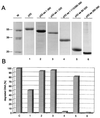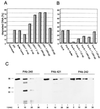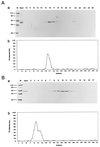Different regulation of the p53 core domain activities 3'-to-5' exonuclease and sequence-specific DNA binding
- PMID: 10022902
- PMCID: PMC84008
- DOI: 10.1128/MCB.19.3.2155
Different regulation of the p53 core domain activities 3'-to-5' exonuclease and sequence-specific DNA binding
Abstract
In this study we further characterized the 3'-5' exonuclease activity intrinsic to wild-type p53. We showed that this activity, like sequence-specific DNA binding, is mediated by the p53 core domain. Truncation of the C-terminal 30 amino acids of the p53 molecule enhanced the p53 exonuclease activity by at least 10-fold, indicating that this activity, like sequence-specific DNA binding, is negatively regulated by the C-terminal basic regulatory domain of p53. However, treatments which activated sequence-specific DNA binding of p53, like binding of the monoclonal antibody PAb421, which recognizes a C-terminal epitope on p53, or a higher phosphorylation status, strongly inhibited the p53 exonuclease activity. This suggests that at least on full-length p53, sequence-specific DNA binding and exonuclease activities are subject to different and seemingly opposing regulatory mechanisms. Following up the recent discovery in our laboratory that p53 recognizes and binds with high affinity to three-stranded DNA substrates mimicking early recombination intermediates (C. Dudenhoeffer, G. Rohaly, K. Will, W. Deppert, and L. Wiesmueller, Mol. Cell. Biol. 18:5332-5342), we asked whether such substrates might be degraded by the p53 exonuclease. Addition of Mg2+ ions to the binding assay indeed started the p53 exonuclease and promoted rapid degradation of the bound, but not of the unbound, substrate, indicating that specifically recognized targets can be subjected to exonucleolytic degradation by p53 under defined conditions.
Figures











Similar articles
-
p53-associated 3'-->5' exonuclease activity in nuclear and cytoplasmic compartments of cells.Oncogene. 2003 Jan 16;22(2):233-45. doi: 10.1038/sj.onc.1206111. Oncogene. 2003. PMID: 12527892
-
Substrate specificity of the p53-associated 3'-5' exonuclease.Oncogene. 2000 Jul 6;19(29):3321-9. doi: 10.1038/sj.onc.1203649. Oncogene. 2000. PMID: 10918588
-
[P53 delta 37 protein exhibits 3'-5' exonuclease activity].Hua Xi Yi Ke Da Xue Xue Bao. 2000 Mar;31(1):21-3. Hua Xi Yi Ke Da Xue Xue Bao. 2000. PMID: 12501603 Chinese.
-
Maintenance of genomic integrity by p53: complementary roles for activated and non-activated p53.Oncogene. 1999 Dec 13;18(53):7706-17. doi: 10.1038/sj.onc.1202952. Oncogene. 1999. PMID: 10618711 Review.
-
The dual role model for p53 in maintaining genomic integrity.Cell Mol Life Sci. 1999 Jan;55(1):12-27. doi: 10.1007/s000180050266. Cell Mol Life Sci. 1999. PMID: 10065148 Free PMC article. Review.
Cited by
-
p53 Acetylation: Regulation and Consequences.Cancers (Basel). 2014 Dec 23;7(1):30-69. doi: 10.3390/cancers7010030. Cancers (Basel). 2014. PMID: 25545885 Free PMC article. Review.
-
Exonucleases: Degrading DNA to Deal with Genome Damage, Cell Death, Inflammation and Cancer.Cells. 2022 Jul 9;11(14):2157. doi: 10.3390/cells11142157. Cells. 2022. PMID: 35883600 Free PMC article. Review.
-
Transcriptional activation of p21Waf1 contributes to suppression of HR by p53 in response to replication arrest induced by camptothecin.Oncotarget. 2018 May 22;9(39):25427-25440. doi: 10.18632/oncotarget.25172. eCollection 2018 May 22. Oncotarget. 2018. PMID: 29875999 Free PMC article.
-
Canonical and non-canonical functions of p53 isoforms: potentiating the complexity of tumor development and therapy resistance.Cell Death Dis. 2024 Jun 12;15(6):412. doi: 10.1038/s41419-024-06783-7. Cell Death Dis. 2024. PMID: 38866752 Free PMC article. Review.
-
Physical and functional interactions between human mitochondrial single-stranded DNA-binding protein and tumour suppressor p53.Nucleic Acids Res. 2009 Feb;37(2):568-81. doi: 10.1093/nar/gkn974. Epub 2008 Dec 9. Nucleic Acids Res. 2009. PMID: 19066201 Free PMC article.
References
-
- Bargonetti J, Manfredi J J, Chen X, Marshak D R, Prives C. A proteolytic fragment from the central region of p53 has marked sequence-specific DNA-binding activity when generated from wild-type but not from oncogenic mutant p53 protein. Genes Dev. 1993;7:2565–2574. - PubMed
-
- Bargonetti J, Reynisdottir I, Friedman P N, Prives C. Site-specific binding of wild-type p53 to cellular DNA is inhibited by SV40 T antigen and mutant p53. Genes Dev. 1992;6:1886–1898. - PubMed
Publication types
MeSH terms
Substances
LinkOut - more resources
Full Text Sources
Research Materials
Miscellaneous
